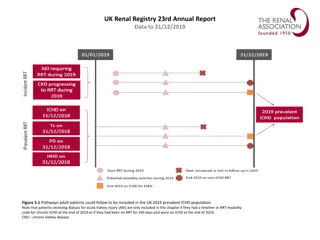
Medicinal Chemistry Drug Design Strategies and QSAR Studies
Explore the quantitative structure-activity relationship (QSAR) studies in organic medicinal chemistry, focusing on predicting pharmacological activity through structural changes and partition coefficients. Learn how drug design strategies aim to optimize compounds for maximum efficacy with minimal testing. Delve into the concept of partitioning in drug distribution and its impact on drug potency and effectiveness.
Download Presentation

Please find below an Image/Link to download the presentation.
The content on the website is provided AS IS for your information and personal use only. It may not be sold, licensed, or shared on other websites without obtaining consent from the author. Download presentation by click this link. If you encounter any issues during the download, it is possible that the publisher has removed the file from their server.
E N D
Presentation Transcript
Organic medicinal chemistry Drug Design Strategies Dr. Hassan Ali
Statistical Prediction of Pharmacological Activity It has been the goal of medicinal chemists to quantify the effect of a structural change on a defined pharmacological response. This would meet three goals in drug design: (a) to predict biological activity in untested Compounds. (b) to define the structural requirements required for a good fit between the drug molecule and the receptor.
(c) To design a test set of compounds to maximize the amount of information concerning structural requirements for activity from a minimum number of compounds tested. The goals of QSAR studies were first proposed about 1865 to 1870 by Crum-Brown and Fraser, They postulated that the physiological action , of a molecule is a function of its chemical constitution, C.
This can be expressed in Equation 2.5: It has been found is that biological response can be predicted from physical chemical properties such as vapor pressure water solubility electronic parameters Steric descriptors and partition coefficients
Let us assume that drug As ED50is 1 mmol and drug Bs ED50 is 2 mmol. Drug A is twice as potent as drug B. In other words, the smaller the ED50(or ED90, LD50, MIC, etc.), the more potent is the substance being tested.
Partition Coefficient The partition coefficient (P) is the ratio of the molar concentration of chemical in the non aqueous phase (usually 1-octanol) versus that in the aqueous phase (Eq. 2.10).
The drug will go through a series of partitioning steps: (a) leaving the aqueous extracellular fluids, (b) passing through lipid membranes, (c) entering other aqueous environments before reaching the receptor In this sense, a drug is undergoing the same partitioning phenomenon that happens to any chemical in a separatory funnel containing water and a nonpolar solvent such as hexane, chloroform, or ether.
The difference between the separatory funnel model and what actually occurs in the body is that the partitioning In the funnel will reach an equilibrium at which the rate of chemical leaving the aqueous phase and entering the organic phase will equal the rate of the chemical moving from the organic phase to the aqueous phase. This is not the physiological situation.
Upon administration, the drug will be pushed through the membranes because of the high concentration of drug in the extracellular fluids relative to the concentration in the intracellular compartments. In an attempt to maintain equilibrium ratios, the flow of the drug will be from systemic circulation through the membranes onto the receptors. As the drug is metabolized and excreted from the body, it will be pulled back across the membranes, and the concentration of drug at the receptors will decrease.
The question that now must be asked is what immiscible nonpolar solvent system best mimics the water/lipid membrane barriers found in the body? One could argue that it was fortuitous that n-octanol was available in reasonable purity for the early partition coefficient determinations. To appreciate why this is so, one must understand the chemical nature of the lipid membranes.
Chemical nature of the lipid membranes These membranes are not exclusively anhydrous fatty or oily structures. As a first approximation, they can be considered bilayers composed of lipids consisting of a hydrophobic tail. Phosphoglycerides are major components of lipid bilayers (Fig. 2.10). polar cap and large
The final result is that these membranes are highly organized structures composed of channels for transport of important molecules such as metabolites, chemical regulators (hormones), amino acids, glucose, and fatty acids into the cell and removal of waste products and biochemically produced products out of the cell.
It turns out that n-octanol is not as nonpolar as initially might be predicted. Water-saturated octanol contains 2.3 M water because the small water molecule easily clusters around octanol s hydroxy moiety. n-Octanol saturated water contains little of the organic phase because of the large hydrophobic 8-carbon chain of octanol. The water in the n-octanol phase apparently approximates the polar properties of the lipid bilayer, whereas the lack of octanol in the water phase mimics the physiological compartments, which are relatively free of nonpolar components. aqueous
In contrast, partitioning systems such as hexane/water and chloroform/water contain so little water in the organic phase that they are poor models for the lipid bilayer/water system found in the body. Remember that the n-octanol/water system is only an approximation of the actual environment found in the interface between the cellular membranes and the extracellular/intracellular fluids.
Method for determination of partition coefficients H.W.
Other Physico-chemical properties Hammett s constant ( ) (electronic parameter) represent electron withdrawing or donating group and its location on aromatic ring. For electronic parameters such as , the location on an aromatic ring is important because of resonance versus inductive effects. Ex. Twofold differences seen between meta and para for the three aliphatic substituents and iodo, and severfold difference for methoxy, amino, fluoro, and phenolic hydroxyl.
Medicinal chemists can use information from extensive tables of physicochemical parameters to minimize the number of substituents required to find out if the biological response is sensitive to electronic, steric, and/or partitioning effects. This is done by selecting substituents in each of the numerical ranges for the different parameters. In Table 2.6, three ranges of MR values (0.92 2.85, 5.02 8.88, and 10.30 14.96); and two main clusters of values, one for the aliphatic substituents and the other for the halogens. In the ideal situation, substituents are selected from each of the clusters to determine the dependence of the biological response over the largest possible variable space.
QSAR model There are three model of equations seen in QSAR analysis using logarithm of (P) as physico-chemical parameter 1.linear model Log1/c=a(logP)+c So linear increase p cause increase BR 1/c defined pharmacological respond (millmole) (ED50 ,LD50 , MIC)
Depending on the biological responses obtained from testing the new compounds, it is possible to determine if lipophilicity (partitioning), steric bulk (molar refraction), or electron-withdrawing/donating properties are important determinants of the desired biological response.
Ex. A study of a group of griseofulvin analogs showed a linear relationship (Eq. 2.15) between the biological response and both lipophilicity (log P) and electronic character ( ). It was suggested that the antibiotic activity may depend on the enone system facilitating the addition of griseofulvin to a nucleophilic group such as the SH moiety in a fungal enzyme
2. Nonlinear model ( parabolic relationship) Because plot indicate nonlinear relationship between biological respond and P Log1/c=a(logP)-b(logP)2+c Ex. substituted acetylated salicylates (substituted aspirins) tested for anti-inflammatory activity. A nonlinear relationship exists between the biological response and lipophilicity, and a significant detrimental steric effect is seen with substituents at position.
L, defined as the length of the substituent along the axis of the bond between the first atom of the substituent and the parent molecule, and B2, defined as a width parameter.
3. Bilinear model: consist of two straight line one ascending and other descending term connect two lines Log1/c=a(logP)-b(log p+1)+c















